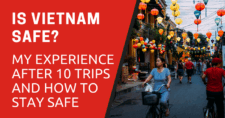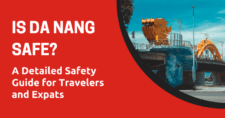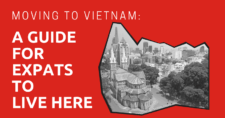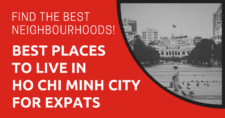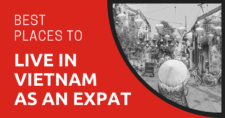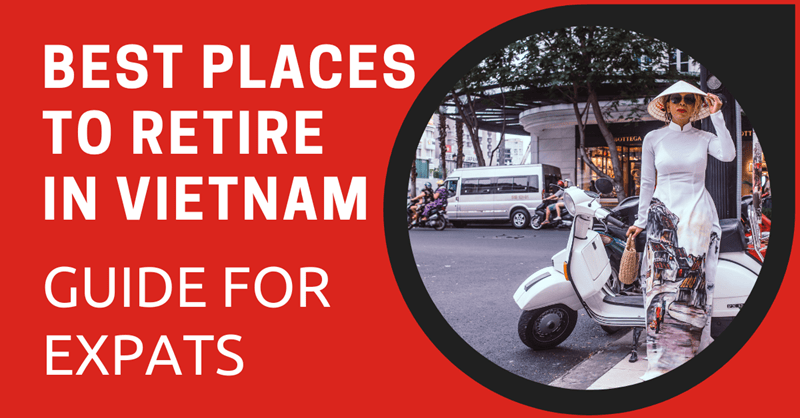
Discover the best places to retire in Vietnam in 2025, from vibrant Ho Chi Minh City to the cool mountains of Da Lat. Compare lifestyle, healthcare, weather, and visa tips to find your ideal spot.
I’ve been to Vietnam many times for work and through my travel business, and I’ve seen firsthand how different life can be from one city to another. I’ve spent time in big cities, small towns, and quiet beach areas, and I’ve met plenty of expats who now call these places home.
This guide isn’t just based on my own trips. I also research in local and expat communities, ask questions in forums, and talk to experts and long-term residents to get a clear picture of what living in each place is really like.
What I’ve found is that the best place to retire in Vietnam depends on what you want. Some people go for the city life and healthcare access in Ho Chi Minh City, others prefer the cultural feel of Hoi An or the beaches in Nha Trang. Some choose cooler weather in Da Lat, while others pick island life in Phu Quoc.
Here, I’ll break down the pros, downsides, and who each place is best for — so you can make a choice with both local insight and real expat experience in mind.
This article will take approximately 33 minutes to read. Don't have the time right now? No worries. Email the ad-free version of the article to yourself and read it later!
Disclaimer: This article may include links to products or services offered by ExpatDen's partners, which give us commissions when you click on them. Although this may influence how they appear in the text, we only recommend solutions that we would use in your situation. Read more in our Advertising Disclosure.
Contents
Visa Situation for Retirees in Vietnam
The first thing I want to tell you about retiring in Vietnam is the visa situation, which is the biggest downside of moving here. At the moment, Vietnam does not offer a retirement visa. This means most retirees rely on tourist visas and have to leave the country regularly to renew their stay.
For most nationalities, the common option is a 90-day single-entry tourist visa, which costs around US$25 according to the U.S. Embassy in Vietnam. Once it expires, you must leave the country and re-enter to get a new one.
This process is called a visa run. You can do it in two main ways:
- By plane: Fly to a nearby country such as Thailand, Malaysia, or Singapore, then return to Vietnam with a new visa.
- By land: Use a visa run service that arranges a bus to the Vietnam–Laos or Vietnam–Cambodia border. You exit Vietnam, get your passport stamped in the neighboring country, then return the same day.
There are other options such as an employment visa or a marriage visa, but they are not suitable for everyone.
Tip: Always monitor your visa closely. Do not overstay under any circumstances. Otherwise, you can be forced to leave Vietnam, like this Slovak man who was deported for tampering with his e-visa. Also, do not trust any visa agent who offers to get you a business visa or marriage visa when you are not eligible for it. Vietnam’s immigration officials are strict, and you definitely do not want to have problems with them.
How to Choose Your City to Retire in Vietnam
Before deciding where to retire in Vietnam, it helps to know what really matters to you day-to-day. Vietnam is a long country, and each area has its own geography and way of life.
When I visit Vietnam, I always notice that my experience changes drastically depending on the city. For example, life in Hanoi, the biggest city in the north, feels slower and more relaxed compared to Ho Chi Minh City (Saigon), where it is much busier and more hectic.
Here are my key decision factors to help you find the best place to retire in Vietnam:
Key decision factors for retirees
- Close to an international airport: This is very important in Vietnam. Since there is no retiree visa at the moment, you need to do a visa run every 60 or 90 days to a nearby country. Having an airport nearby makes this much easier. While you can take a bus, it’s not for everyone. A round bus trip to the border can take more than 10 hours.
- Healthcare access: Health is a big priority for retirees. When you are sick, you want to be sure there are good hospitals nearby. Not all cities in Vietnam have high-quality medical facilities.
- Weather: Some cities can be great to live in but also too hot at certain times of the year. The south has a warmer tropical climate year-round, while the north has a cooler winter.
- Typhoons: Many coastal cities in Vietnam get hit by typhoons regularly, usually between September and November.
- Language support: Unless you plan to learn Vietnamese, you may want to live in a place where some people can speak English. This makes daily life much easier.
- Hobbies: Whether you are into beaches, hiking, art, or golf, pick a place where your favorite pastimes are easy to access. Also, decide whether you want to live in a big city with more convenience or a smaller city with a slower pace.
I am not including the cost of living here since Vietnam is generally very affordable, even in Ho Chi Minh City. You can still have a comfortable life here with a budget of less than US$1,000 a month.
Best Cities to Retire in Vietnam
These are the best cities to retire in my opinion, and they are also popular among expats in Vietnam.
Da Nang
I fell in love with Da Nang the moment I arrived. It’s one of the cities I would seriously consider if I ever plan to retire in Vietnam. Even my wife, who usually isn’t into the idea of living in Vietnam, liked it. The city is also very safe.
Da Nang is also one of the most popular cities to live in Vietnam. There’s an active expat Facebook group called Expats in Danang with over 60,000 members, which shows how big the foreign community here has grown.
A local guide I spoke with a few months ago also told me that Da Nang is one of the most popular cities in the country for tourism, with both domestic and international visitors year-round.
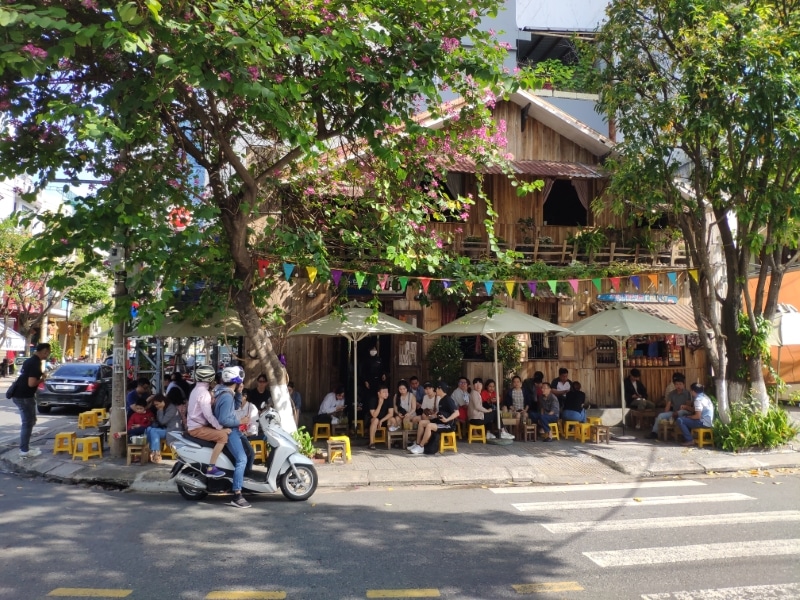
Quick pros and cons
- Pros: Balanced lifestyle: beach, river, and city amenities; Easy to get around; Good mix of local and expat community; Close to an international airport for visa runs
- Cons: Typhoon season Hot and humid weather for much of the year; May need to travel for advanced healthcare
Lifestyle
Da Nang has just about everything. It’s easy to get around and the food is amazing. I once did a full-day food tour here, eating at over 10 different restaurants, and enjoyed every single stop.

Danang has a bustling with nomads and retirees alike. People go for beach life, low rents, cleaner air, exercise options, golf and lower overall costs of living.
Quinn Miller, Managing Partner of Tenzing Pacific Services, an insurance firm based in Vietnam.
The infrastructure works well. The city isn’t as hectic as Ho Chi Minh City. There’s a river running through the center where I often saw families and couples walking together and enjoying the evening. On top of that, there are some good beaches right on the edge of the city.
Healthcare
While I haven’t personally needed medical care here, Da Nang has branches of Family Medical Practice: a reputable private healthcare network in Vietnam. They are good for common illnesses and general checkups.
For major diseases or surgeries, many retirees travel to Ho Chi Minh City for treatment. Personally, I might fly to Bangkok instead for advanced care because of its internationally accredited hospitals.
In fact, many expats I know schedule annual checkups in Bangkok or Singapore for specialty care.
Visa Run
One of Da Nang’s strong points is its airport, which is only about 15 minutes from the city center. This makes doing a visa run by plane very easy. If you prefer doing a land border run, there are visa agents here who arrange buses to Laos or Cambodia.
You can watch this YouTube video of a full visa run by bus from Da Nang to see what the process looks like.
Climate
The downside here is the weather. Da Nang can be hot with an average daytime temperature around 29°C (84°F) most of the year. However, in most cases, you feel hotter than that because of the humidity.
In addition, the typhoon season runs from roughly September to November, bringing strong storms and heavy rain. Some residents temporarily relocated to Ho Chi Minh City or Phu Quoc during this period.
“Typhoon season isn’t fun. I just pack up and spend two months in Saigon every year. Makes life easier.”
Neighborhoods
Most retirees start in My An or An Thuong because these areas have good walkability, plenty of services, an active community, and are next to beaches.
“My An is the perfect balance. I can walk to cafés, the beach, and my friends live nearby.”
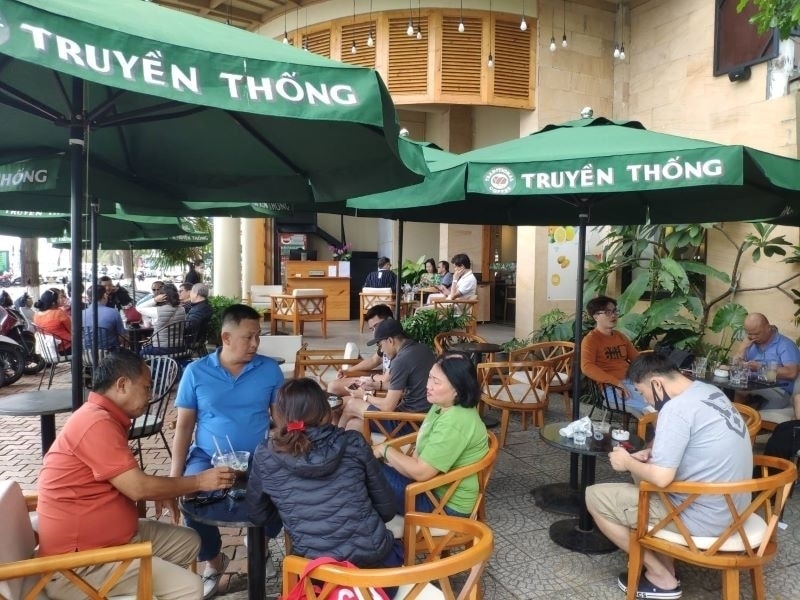
Downside
The biggest downside of Da Nang is the weather. Summers can get very hot, and the rainy season can feel endless with heavy downpours. If you’re sensitive to heat or humidity, it might be tough to handle.
Who Should Retire in Da Nang?
In my opinion, Da Nang is ideal if you want a balance of city conveniences and a relaxed life with beach access. The city is walkable, with easy airport access, good food, and a lively but not chaotic pace of life. However, it’s not the best choice if you are sensitive to heat and prefer somewhere cooler.
Hoi An
It’s the most beautiful city I’ve ever visited in Vietnam. The old town is a UNESCO World Heritage Site and has a charm you won’t find anywhere else in the country.
However, I prefer Da Nang’s food more. In Hoi An, there are many restaurants aimed at tourists, which I find more expensive and not as flavorful as truly local food. The good news is it’s just about an hour from Da Nang, so you can easily enjoy both places.
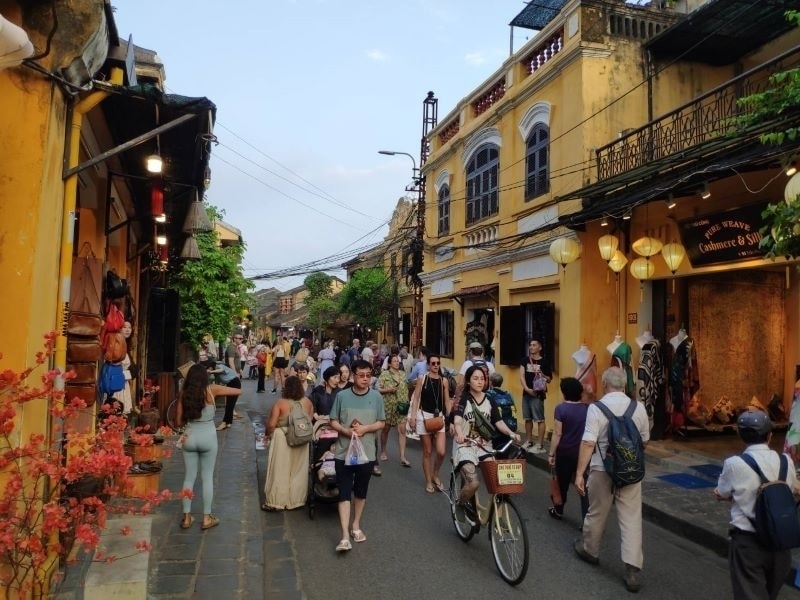
Quick pros and cons
- Pros: Quieter pace; Restored old town with unique architecture; Beach communities just outside town; Small but active retiree circle; Easy day trips to Da Nang
- Cons: Limited healthcare; Tourist-focused dining scene; Typhoon and flooding risk in wet months; Reliance on Da Nang for airport access
Lifestyle
Hoi An has a slower pace of life compared to bigger cities. The old town’s lantern-lit streets, riverside cafés, and traditional markets create a romantic atmosphere, while the nearby beach communities offer a laid-back vibe.
The city also gives you a nice balance. You can enjoy Western music, noise, and fun when you’re in the mood, and just a few blocks away it’s quiet and calm. A taxi to the beaches and relaxed beach bars costs around 150,000 VND.
Fresh food is easy to find, from street stalls to restaurants, and prices are generally reasonable. Plenty of people speak English here, but there’s still a lot of culture and history to explore.
The main downside is that many restaurants cater to tourists, which means higher prices and, in my opinion, food that isn’t as good as what you get in Da Nang. Luckily, Da Nang is only an hour away, making it easy to visit for better food options, modern shopping, or a livelier nightlife.
Healthcare
Hoi An has limited private healthcare options. Most retirees go to Da Nang for anything beyond basic care, where facilities like Family Medical Practice are available.
If you have ongoing medical needs, you will likely make regular trips to Da Nang.
Climate
Since it’s only an hour away from Da Nang, it has pretty much the same weather, which is warm and humid for most of the year. It also suffers from the typhoon season that runs from roughly September to November.
If you plan to live in Hoi An, don’t rent in low-lying areas. Flooding is very common there, especially near the river.
“The flooding can be annoying, but I like the quiet pace here. You just plan your shopping around the rain.”
Neighborhoods
Popular areas include
- An Bang and Cam An for proximity to the beach and closer to tourist places.
- Cam Chau offers a quieter lifestyle but is still close enough to bike to the beach in 15 minutes.
Downside
Hoi An shares the same weather pattern as Da Nang since they’re so close. That means hot summers, a rainy season that can bring flooding in low-lying areas, and high humidity most of the year.
The old town can also get crowded with tourists, especially during peak season, which can take away from its charm.
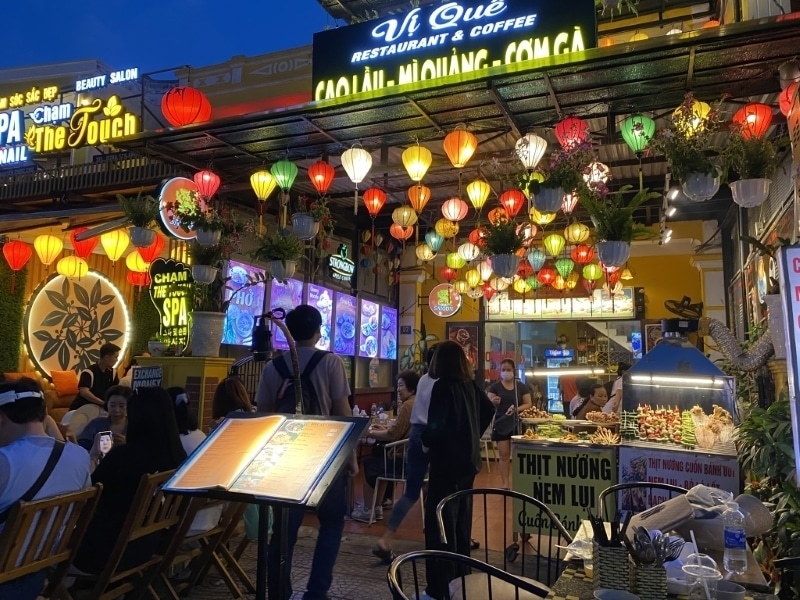
Who Should Retire in Hoi An?
In my opinion, Hoi An is best if you want to live in a quieter, small-town lifestyle with cultural charm and don’t mind traveling to Da Nang for major shopping, healthcare, and international flights.
Da Lat
If you want to live somewhere that’s cool throughout the year without any typhoon problems, you should check out Da Lat. It’s called the “Switzerland of Vietnam” for good reason. In the past, French colonialists built it as a retreat city, and the weather was the main reason they chose Da Lat. That same reason is why many people, including retirees, still choose to live here today.
The city has a European feel, with French-style villas and old hotels that have been around for decades.
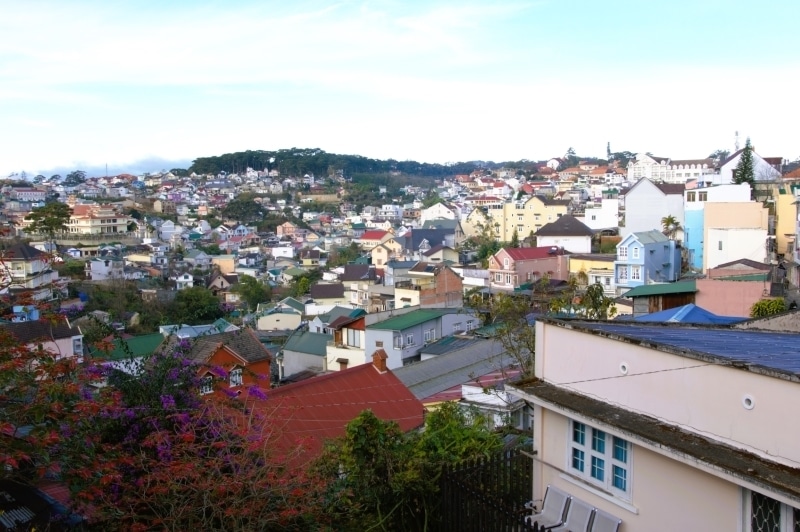
Quick pros and cons:
- Pros: Cool weather all year; Scenic mountains and lakes; Fresh air most of the time; No typhoons; Great local produce and flowers
- Cons: Far from the sea; Limited healthcare; Long travel for visa runs; Smaller expat community compared to coastal cities
Lifestyle
It’s like living in a city surrounded by mountains, with fresh air almost all year. Da Lat is convenient enough for day-to-day life but can still be busy in the city center since it’s a popular travel destination. This is the place for café hopping, visiting fresh produce markets, and exploring flower gardens or waterfalls on weekends.

Dalat has a Georgia tea plantation, rice fields, and a beautiful lake. It’s a charming place that’s very green, beautiful, and cooler. It’s a great place to live if you don’t want hot weather in summer.
Dan from the Vagabond Awake. His YouTube Channel has thousands of video reports showcasing his tours of the 80 best cheap retirement destinations in the world.
Products here are often local, and they really taste fresh. I still remember arriving on an overnight bus from Ho Chi Minh City, stepping off into the cool morning air, and having a fresh, warm tofu drink from a street vendor. It was simple but so refreshing. Da Lat is not a walkable city, so the best way to get around is by scooter.
The good news is it’s much easier to ride here than in cities like Hanoi or Ho Chi Minh City because traffic isn’t as hectic.
Healthcare
Since it’s not a big city, there are only smaller hospitals and clinics here, good for basic care but not advanced treatment. For anything serious, you’ll need to go to Ho Chi Minh City. You can take a bus or minivan for 6–8 hours, or fly from Lien Khuong Airport to HCMC in under an hour.
Climate
Weather is the best thing about living in Da Lat. Temperatures stay between 15°C and 24°C year-round: not too warm and not too cold. The city is also sunny with less rain and has no typhoon problems like many coastal cities in Vietnam.
However, there can be air quality issues during the burning season, when farmers burn agricultural waste in nearby areas. While it’s not as severe as in northern Thailand’s Chiang Mai or Chiang Rai, you can still notice haze and smoky air on certain days.
“Heat and humidity in Da Nang and Hue were tough. Doctor advised moving to Da Lat… best decision.”
“I like cooler temps, but two hours to the beach is a trade-off.”
Neighborhoods
It’s better to start in the central wards near the market or Xuan Huong Lake so you can walk to shops, cafés, and restaurants. Once you know the city, you can move to quieter hillside neighborhoods for more space and greenery.
If you plan to live outside the central area, you may need to learn some Vietnamese to get by comfortably.
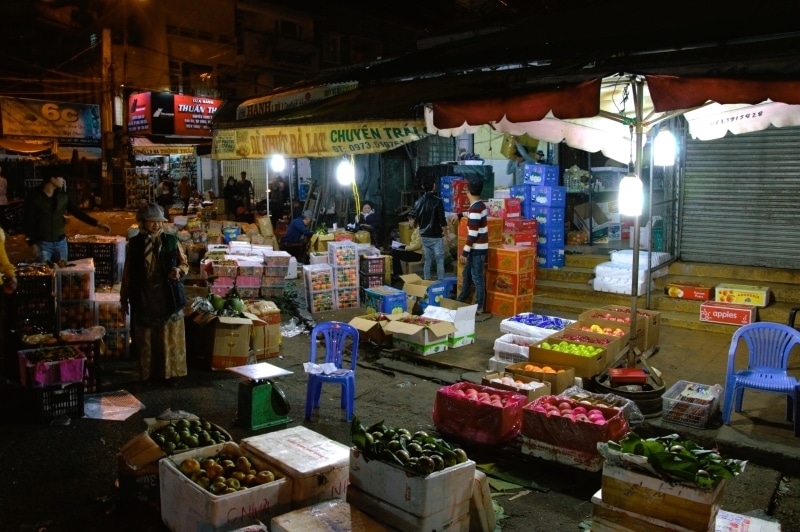
Downsides
There are a few downsides to living here. First, getting to Da Lat isn’t as convenient as other cities in this article, where you can take an international flight directly.
Here, you usually need to travel to Ho Chi Minh City first and then take an hour-long domestic flight or an 8-hour road trip. That’s not ideal when you need to do a visa run every 90 days.
Da Lat is also far from the beach, and there’s no major hospital for expats. Also, since there isn’t a lot of things to do there. You can get bored after you live here for a year or two.
Who Should Retire in Da Lat?
In my opinion, Da Lat is perfect if you want cool, fresh weather and don’t mind being far from the coast. It’s a great choice if you enjoy gardening, outdoor walks, and a slower pace of life. But it’s not the most practical option if you need regular international travel or easy access to advanced medical care.
Nha Trang
For me, Nha Trang is one of the best beach cities in Vietnam. You get a long stretch of sand right in the heart of the city, plenty of sun, and a solid mix of local life and expat conveniences. The city also has good infrastructure, reliable hospitals, and weather that stays pleasant most of the year.
Quick pros and cons
- Pros: Great year-round climate with plenty of sunshine; Established expat community; Good hospital access; Beach right in the city; Affordable cost of living
- Cons: Fewer cultural and sightseeing options than some other cities; Hot tropical weather; Can be touristy in certain areas; Russian tourist presence may not be for everyone
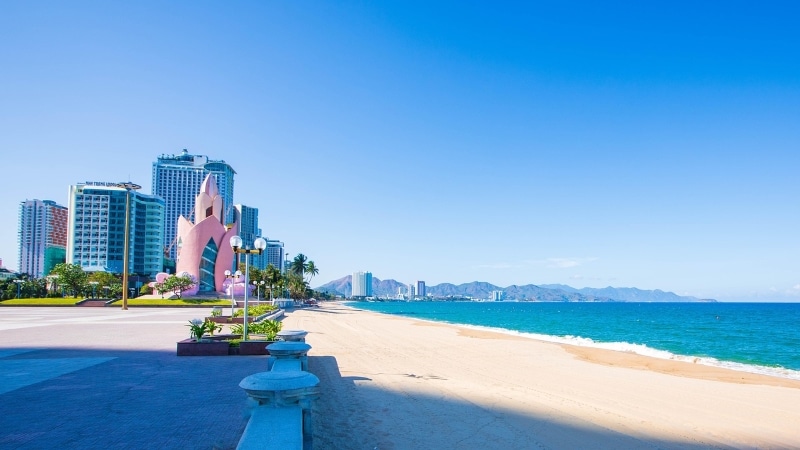
Lifestyle
Nha Trang has everything you’d want from a laid-back beach city. I personally like the northern part of the city. It’s quieter, surrounded by nature, cheaper, and traffic isn’t bad.

Nha Trang has, on average, 6 or more hours of sunshine per day than Da Nang in 11 months of the year. I’m a sunny weather guy, and weather plays a big role for me. So, I want to switch from Da Nang to Nha Trang.
Dan from the Vagabond Awake. His YouTube Channel has thousands of video reports showcasing his tours of the 80 best cheap retirement destinations in the world.
Finding food is easy. As soon as you step outside, you’ll see it everywhere, from cheap local stalls to cafés and beer spots. While Western food is still limited, there’s even a McDonald’s if you’re craving it. The expat community here is big too. For example, Nha Trang Expats has over 30,000 members, which makes it easier to meet people or get advice from other foreigners.
Healthcare
One thing that sets Nha Trang apart from most smaller coastal cities in Vietnam is healthcare. You’ll find Vinmec International Hospital and other private clinics here, which is rare outside of Hanoi or Ho Chi Minh City.
Having both a beach lifestyle and good hospital access in the same place is hard to find in Vietnam.
Climate
The weather is warm year-round, with average daytime temperatures between 21°C and 32°C, and the ocean stays comfortable for swimming. Nha Trang only has about two months of rainy season, and even then, it doesn’t rain heavily. It also gets fewer typhoons compared to Da Nang.
Housing and neighborhoods
You can choose between modern beachfront high-rises or quieter inland streets. For me, the northern neighborhoods are the best for a more peaceful vibe, with good access to nature and a slower pace of life.
Downsides
Nha Trang doesn’t have as many cultural attractions as cities like Hoi An or Hue, so if sightseeing is a priority, you might find it limited.
It’s also worth noting that for visa runs, you’ll likely need to connect through Ho Chi Minh City. It’s not difficult, but not as direct as being in a major hub.
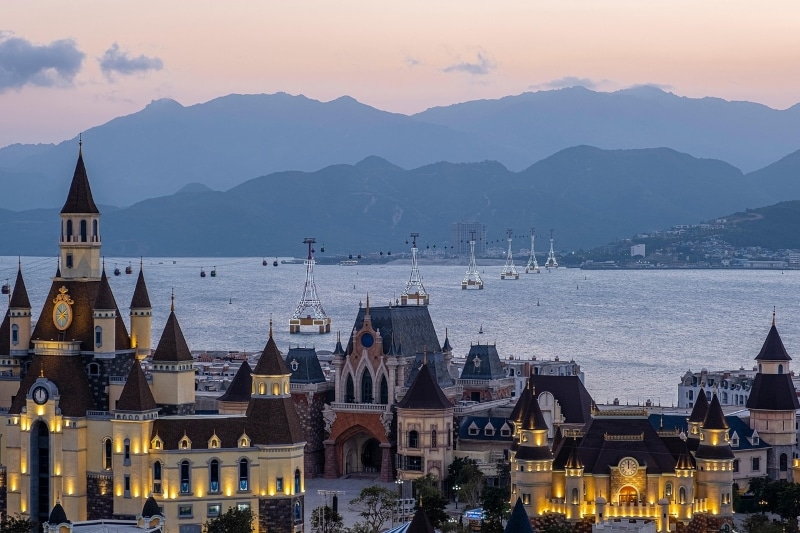
Who Should Retire in Nha Trang?
In my opinion, Nha Trang is perfect if you want a warm, sunny beach lifestyle with good healthcare and a low cost of living. It’s not for you if you’re looking for cooler weather or a city packed with cultural attractions, but if your goal is to relax, swim, and enjoy a tropical climate most of the year, it’s hard to beat.
If you like the Nha Trang vibe but prefer something smaller and more laid back, you should check out Quy Nhon. It has good beaches, fewer tourists, and a quieter pace of life.
Ho Chi Minh City (Saigon)
For me, Ho Chi Minh City, or Saigon as many still call it, is Vietnam’s best choice if you want to live a city lifestyle with quality healthcare, easy international travel, and all the conveniences of a big city. It’s the country’s main hub for business, flights, and private hospitals, so you’ll never be far from anything you need.
Quick pros and cons
- Pros: Best healthcare access in Vietnam; Direct international flights; Endless dining and shopping options; Large and diverse expat community; Plenty of nightlife activities
- Cons: Hot and humid year-round; Heavy traffic; No beach; Crowded; Expensive and noisy
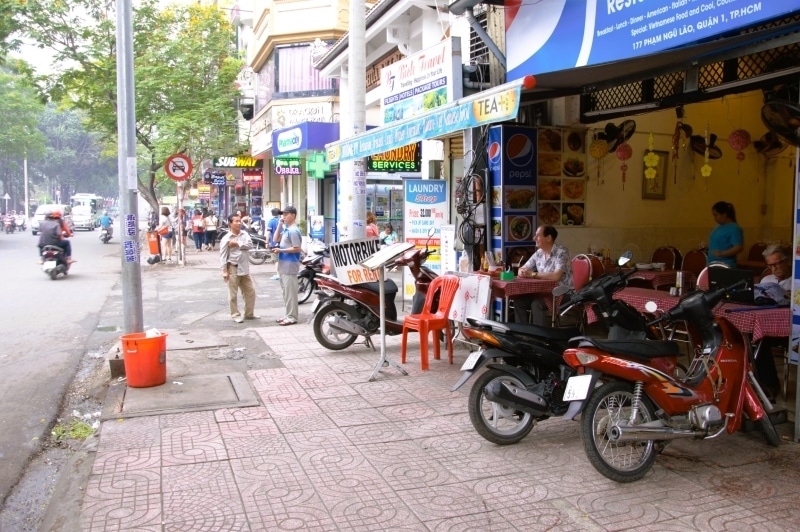
Lifestyle
Like other capital cities in the world, Ho Chi Minh City is fast-paced, busy, and full of energy. With my background living in Bangkok, I saw many similarities between the two: plenty of private hospitals, places to rent, convenience, and international food. But Ho Chi Minh doesn’t have a good mass transit system like Bangkok. However, it’s cheaper and has far better coffee (though there are also way more motorcycles).
When living in Ho Chi Minh City, you’ll find international restaurants alongside tiny street stalls, high-end malls next to local markets, and something happening all the time in every neighborhood. If you enjoy having access to everything, especially nightlife, Saigon delivers.
But it’s not a relaxing beach town, expect an active lifestyle. Just keep in mind that traffic to the city center can be a headache.

Hanoi & Ho Chi Minh City are becoming ever more populated, polluted and expensive
Quinn Miller, Managing Partner of Tenzing Pacific Services, an insurance firm based in Vietnam.
Climate
Saigon’s weather is hot and humid all year, with daytime temperatures usually between 25°C and 35°C. It rains a lot from May to November, but not as much as in Central Vietnam like Da Nang, and the city is rarely hit by typhoons.
Overall, the weather feels similar to other tropical cities like Bangkok. If you’re okay with heat, you’ll be fine.
One thing worth noting is the air pollution, especially during the dry season which can exceed the WHO guidelines. Many expats complain about it, though it’s still not as bad as Hanoi. You can check the latest readings on IQAir.
Healthcare
This is where Saigon really stands out. It has the best private hospitals in the country, including FV Hospital and international clinics like Family Medical Practice. If you want to retire in Vietnam and need to be somewhere with good healthcare, Ho Chi Minh City is the top choice.
Neighborhoods
Thao Dien and Phu My Hung are the most popular expat neighborhoods, offering modern apartments, green spaces, and plenty of Western conveniences. If you want a more local feel, districts like Binh Thanh and District 3 have lower rents and great street food, but with less English spoken.
Find out more: Best Places to Live in Ho Chi Minh City For Expats
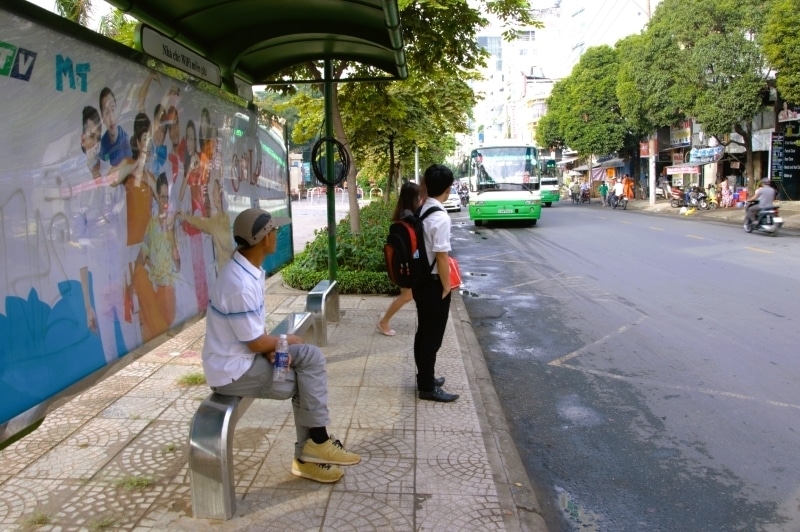
Downsides
The biggest downsides are the traffic, heat, and lack of a beach. Air quality can also be an issue. If you prefer a slower pace or easy access to nature, you may feel overwhelmed here.
Who Should Retire in Ho Chi Minh City?
In my opinion, Saigon is perfect if you want to live an urban lifestyle with access to quality healthcare. There are plenty of food options, shopping, and entertainment in the city. On the other hand, it’s not for you if you want cooler weather, a quieter lifestyle, or beach access.
Other
The above list covers what I think are the 5 best places to retire in Vietnam. There are also other cities that could be good options depending on the lifestyle you’re after:
- Quy Nhon: A smaller beach city that’s quieter and less touristy than Nha Trang. It’s a good place if you want a completely laid-back lifestyle without the crowds. However, expat amenities are limited.
- Hanoi: The capital city in the north with cooler weather, less traffic, and a more traditional atmosphere than the south. I personally like the food in Hanoi too (only second to Da Nang). However, winters can be chilly, and there’s a problem with air pollution here.
- Phu Quoc: It’s the largest island in Vietnam with a growing expat scene. It can be a good place if you want to retire on a developed island.
- Hue: Another UNESCO World Heritage city in central Vietnam, Hue is full of culture, centuries-old history, royal architecture, and a quieter pace. However, rains can be heavy, and typhoons can be a problem, similar to Da Nang.
- Vung Tau: A coastal city just a couple of hours from Ho Chi Minh City, Vung Tau is a popular weekend escape for beach lovers. It offers good seafood, a break from city life, and easy access to Saigon’s amenities.
Best Cities to Retire in Vietnam Comparison
If you’re still deciding which city might be the right fit, this comparison table can help you see the differences at a glance. It covers lifestyle, climate, healthcare, airport and beach access, ease of visa runs, expat community size, rent prices, and storm exposure.
This way, you can quickly match your preferences to a city that fits your retirement plans in Vietnam.
| City | Lifestyle | Climate | Healthcare Access | Airport Access | Beach Access | Ease of Visa Run | Expat Scene Size | Avg. Rent (1-bed near amenities) | Storm Exposure |
| Da Nang | Balanced beach, river, and city amenities; walkable areas | Hot & humid most of the year | Good for basic care; advanced care in HCMC/Bangkok | 15 min from city center | Yes | Very easy | Large (60k+ FB members) | ~$350–$500 | Yes (Sep–Nov typhoon season) |
| Hoi An | Quiet, cultural charm; beach communities nearby | Similar to Da Nang | Limited; relies on Da Nang | 1 hr to Da Nang airport | Yes | Easy (via Da Nang) | Small but active | ~$300–$450 | Yes (flood-prone in wet months) |
| Da Lat | Cool mountain city; café culture | 15–24°C year-round | Limited; serious care in HCMC | 30 min to Lien Khuong Airport, then domestic flight | No (2+ hrs to coast) | Hard (long travel for visa runs) | Small | ~$250–$400 | No typhoons |
| Nha Trang | Laid-back beach lifestyle | Warm year-round; short rainy season | Good (Vinmec & private clinics) | 45 min to Cam Ranh Airport | Yes | Moderate (often via HCMC) | Medium-large | ~$300–$500 | Low (fewer typhoons) |
| Ho Chi Minh City | Urban, fast-paced; top dining, shopping, nightlife | Hot & humid year-round | Best in Vietnam | Tan Son Nhat Airport in city | No | Very easy (direct intl. flights) | Large & diverse | ~$400–$700 | Minimal storm impact |
| Quy Nhon | Quiet coastal city; fewer tourists | Warm, less crowded | Limited; relies on bigger cities | Phu Cat Airport nearby | Yes | Moderate | Small | ~$250–$400 | Low |
| Hue | Historic & cultural; slower pace | Hot summers; wet winters | Limited; advanced care in Da Nang/HCMC | ~30 min to Phu Bai Airport | Nearby beaches | Moderate | Small | ~$250–$350 | Yes (typhoon season) |
| Vung Tau | Coastal city near Saigon; seafood & beach walks | Hot & humid | Limited; advanced care in HCMC | 2 hrs from HCMC airports | Yes | Easy (close to HCMC) | Medium |
Where to Retire in Vietnam
This section will help you match your lifestyle priorities with the best retirement spots in Vietnam. Whether you want top healthcare, a beach lifestyle, cultural richness, or the country’s best weather, there’s a place here that fits.
Big-City Life with Top Healthcare
If you want a modern, urban lifestyle with everything close by, Ho Chi Minh City (Saigon) or Hanoi are the best picks.
- Ho Chi Minh City is Vietnam’s main hub for business, flights, and private hospitals like FV Hospital and Family Medical Practice. You’ll have endless dining, shopping, and nightlife, but also heavy traffic and hot, humid weather year-round.
- Hanoi offers a cooler climate, traditional architecture, and a rich food scene. Winters can be chilly, and air pollution is an issue, but it’s a good choice if you prefer a slower pace while still having solid amenities.
Moderate Town, Still Convenient
Da Nang is the most popular expat city in Vietnam and also my favorite city. It gives you a balance of convenience and a more relaxed pace. It has great food, good infrastructure, an international airport, long beaches, and a growing expat community.
You still get modern amenities without the chaos of a big city, but the rainy season can be intense and typhoons do happen.
Beach-First Lifestyle
If the beach is your main priority, these places are worth looking at:
- Nha Trang: A rare mix of city beachfront and good hospital access. The quieter, cheaper northern neighborhoods are surrounded by more nature. It’s ideal for swimming and relaxing year-round, but cultural attractions are limited and touristy spots can get crowded.
- Quy Nhon: A quieter alternative to Nha Trang with clean beaches, fishing villages, and a laid-back pace. Still affordable and not overrun with tourists, but amenities are more limited.
- Vung Tau: Just a couple of hours from Saigon, great for quick city access while enjoying a coastal lifestyle. Popular on weekends, quiet during the week, with plenty of fresh seafood.
- Phu Quoc: Developed island living with beaches, resorts, restaurants, an international airport, and basic healthcare.
Cultural Charm
For a slower pace and history-rich surroundings:
- Hoi An – Famous for its UNESCO-listed old town, lantern-lit streets, and riverside cafés. Peaceful with nearby beaches and just a short trip to Da Nang for airport and hospital access.
- Hue – Known for royal palaces, ancient temples, and imperial cuisine. Quiet and traditional, but expect heavy rains and occasional typhoons.
Best Weather Year-Round
If you want a mild, spring-like climate, Da Lat is your spot. Surrounded by pine forests and flower gardens, it’s a relaxed place with great fresh produce. The only downside is limited healthcare. Major treatments mean a trip to a bigger city.



